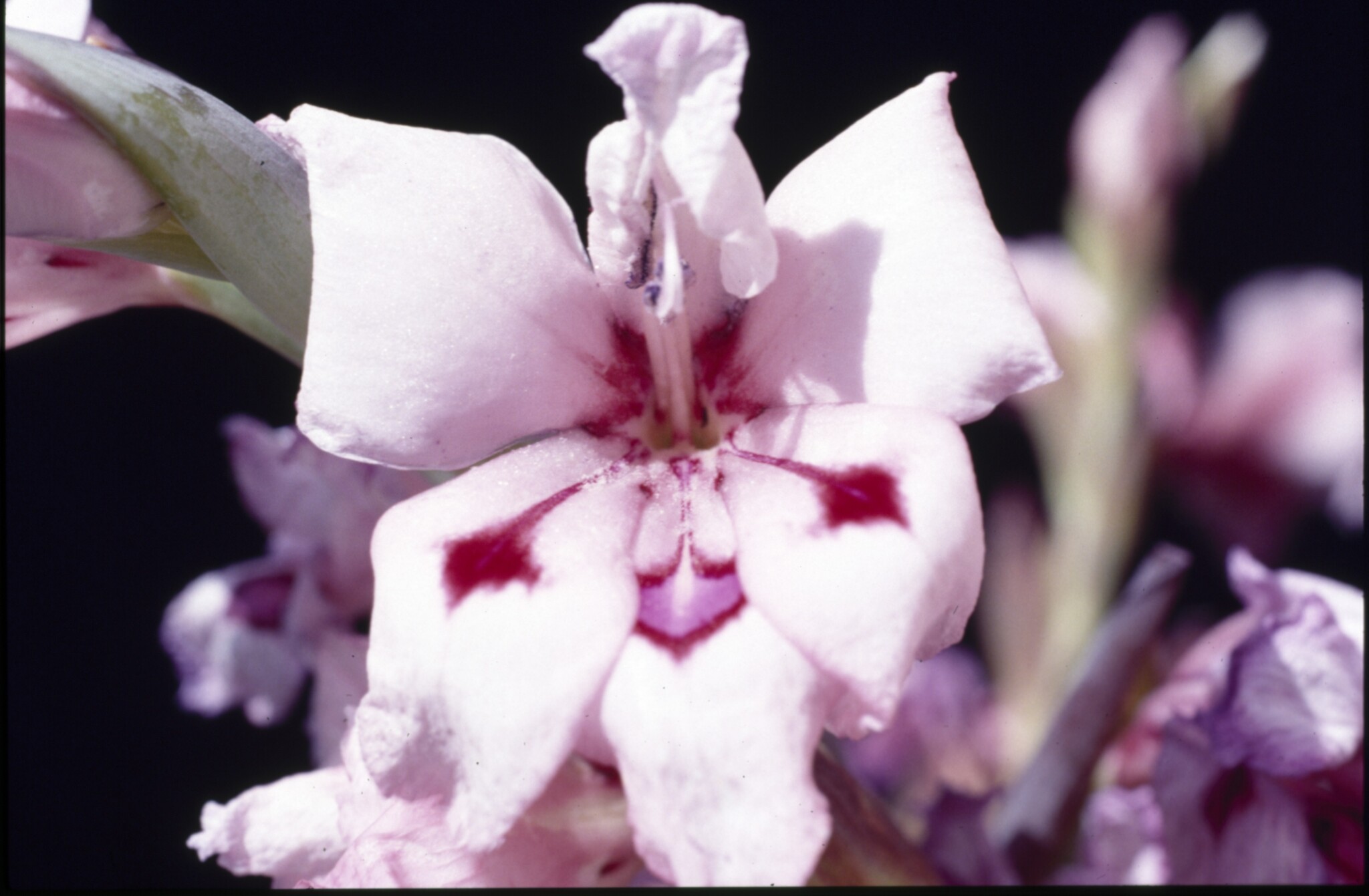
Latin gladiolus – a short sword, from the shape of the leaves.
Perennial herbs. Corms globose to flattened with papery or fibrous tunics. Leaves mostly basal, with distinct midvein. Spathes green, ridged, usually as long as perianth tube. Perianth tube irregular; tube evenly tapering or pouched, curved, funnel-shaped at tip; lobes almost equal or the upper three larger, the lower three often bearing arrow-shaped coloured patches ('darts'). Stamens arched above the style, equal. Seeds flat, winged.
255 species in Africa and the Mediterranean.
Offsets.
Medium to large plants with showy flowers; perianth tube sheathed by a green spathe.
Lewis et al. (1972), Anderton & Park (1989), Van Raamsdonk & De Vries (1989), Goldblatt, P. (1996), Goldblatt & Manning (1998).
Source: (2005). Iridaceae. In: . Horticultural Flora of South-eastern Australia. Volume 5. Flowering plants. Monocotyledons. The identification of garden and cultivated plants. University of New South Wales Press.

Plants 70-110 cm tall. Flowers 7-10 cm wide in an erect congested spike. Colours range from yellow to reds and pastel shades, often with a contrasting centre and ruffled segments. Summer.
Derived from the Grandiflorus hybrids.
Flowers large, maroon.
Flowers greenish-yellow.
Flowers mauve with pale apricot throat
Flowers clear yellow.
Plants 30-40 cm tall. Flowers 4-7 cm wide in a loose arching spike of 4-10. Perianth upturned, trumpetshaped, white to red with prominent darts; lobes usually with very wavy edges. Spring.
The original G. colvillei Sweet was an F1 hybrid of G. tristis and G. cardinalis having deep pink flowers with a cream stripe on each of the lower perianth lobes. However, other S African species such as G. carneus may have contributed to this group.
Flowers pale rose pink, with darts of deeper pink and white
Flowers muted pink with cream and maroon darts.
Flowers bright orange-red.
Flowers pure white with yellow shading along the midline of each lobe.
Plants 1-1.5 m tall. Flowers of almost any colour, 10-16 cm wide, 10-20 in an erect congested spike. Summer.
Grown extensively for cut flowers and exhibition. This group originated with F1 hybrids of G. dalenii and G. oppositiflorus which were marketed as G. 'Gandavensis' by Van Houtte in Belgium around 1840. G. cardinalis, G. cruentus, G. papilio, G. saundersii and others have also contributed to modern polyploid cultivars such as:
Flowers pure white, ruffled lobes, cream inside tube.
Flowers dark purple, almost black.
Flowers blue-mauve with cream-white blotch on lower segments.
Flowers deep orange.
Flowers purple with ruffled lobes.
Flowers dark red.
Flowers gold, with tangerine picotee edges.
Flowers bright yellow.
Flowers pale lime green, with ruffled lobes.
Flowers ruffled lilac, shading to white in centre.
Flowers orange-red.
Flowers pure white.
Flowers golden yellow with large orange-red patch on lower lobes and ruffled edges.
Flowers deep violet.
Flowers rose-pink shading to white in centre.
Flowers rose-magenta with white centre.
Flowers lemon yellow.
Flowers orange-salmon with red shading in centre.
Flowers bright pink with red centre and ruffled lobes.
Flowers deep purple.
Flowers magenta with a white ring in centre.
Flowers deep rose.
Flowers red with white throat.
Flowers white with some yellow shading in throat.
Plants 30-60 cm tall. Flowers 5-8 cm wide in loose spikes of 3-8. Spring.
Similar to the Colvillei group but with a greater variety of form and colours, derived from several S African species.
Flowers white with purple anthers.
Flowers palest blush pink, with maroon darts.
Flowers pale mauve-pink with cream throat
Flowers pale pink with red darts.
Flowers white with dark red darts.
Flowers purple with lilac darts.
Flowers crimson.
Flowers carmine with cream darts.
Flowers flesh pink with a crimson stripe on each lower segment.
Plants 70-100 cm tall. Flowers 5-10 cm wide with a hooded or drooping top segment, in looser spikes of 10-20. Colours range from yellow to reds and pastel shades. Summer.
Bred in the 20th century from crosses of Grandiflorus cultivars with the yellow form of G. dalenii formerly known as G. primulinus. Popular cultivars include:
Flowers orange-scarlet with slightly frilled cream margins.
Gladiolus 'Princess Margaret Rose'
Flowers orange-red with yellow lower segments.
Flowers cerise, shaded paler pink in centre.
Flowers white, shaded yellow in throat.